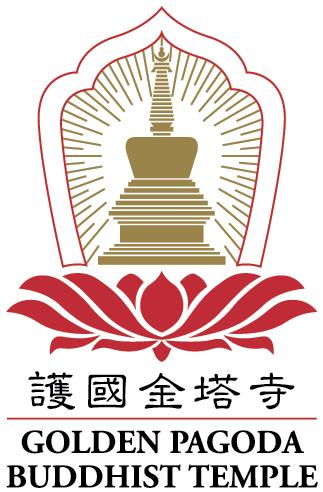
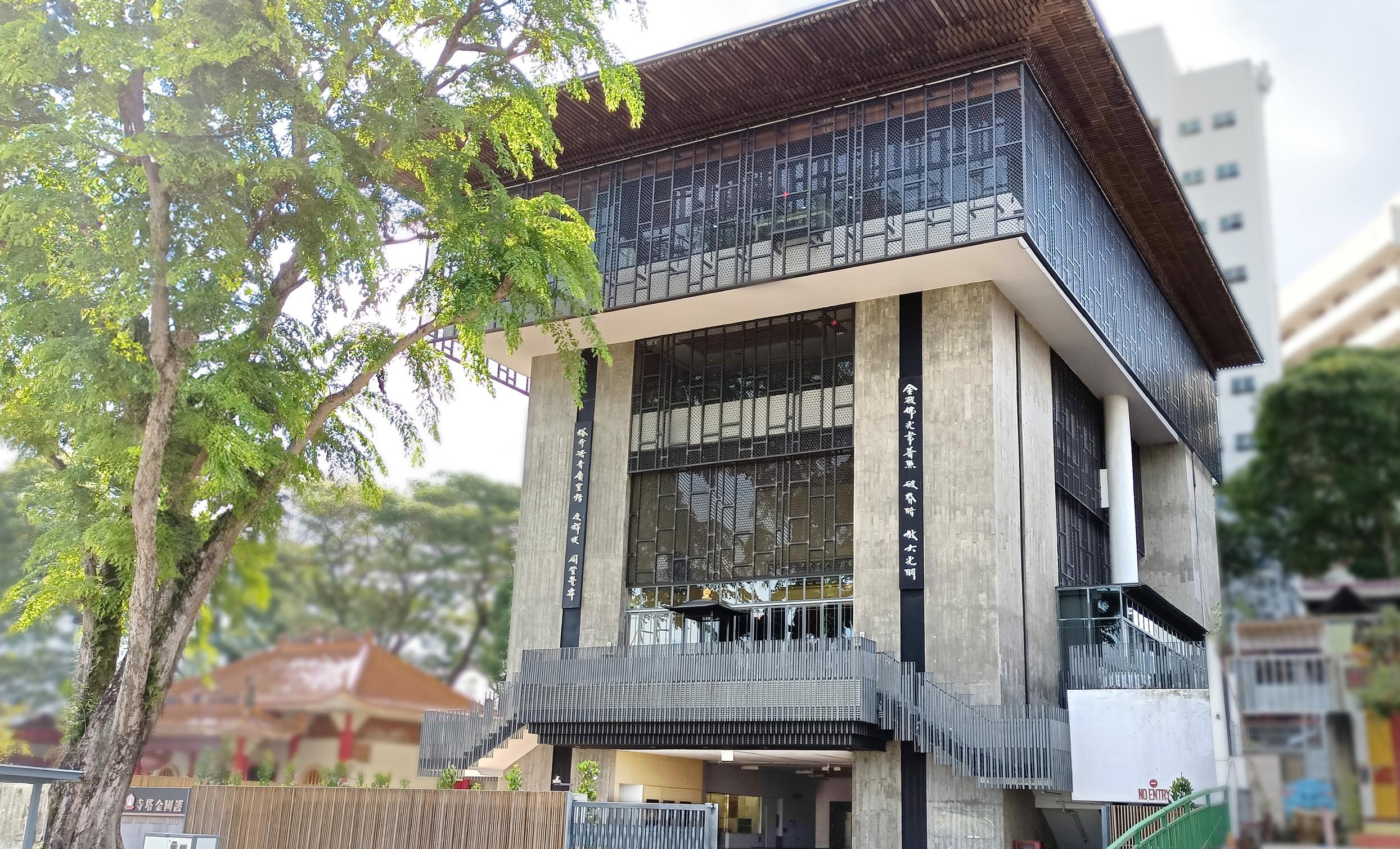
Table of Content
President's Message
理事会主席献词
Introduction
简介
Management Committee
理事会
Organisation Chart
组织架构图
Events
活动
Donations
捐款
Governance
守则
Summary Financial Performance
财务报表摘要
Financial Report
财政报告



President's Message
理事会主席献词
Introduction
简介
Management Committee
理事会
Organisation Chart
组织架构图
Events
活动
Donations
捐款
Governance
守则
Summary Financial Performance
财务报表摘要
Financial Report
财政报告

Venerable Chao Khun Fa Zhao BBM President, Management Committee
Golden Pagoda Buddhist Temple
昭坤法照 BBM
护国金塔寺理事会主席
南无佛!诸位法师、护法信众、诸位贤善大德吉祥:
2024年,我们一同走过充满挑战与希望的一年,点亮信仰的灯,温暖彼 此的心。
在佛法的引领下,護國金塔寺与大众携手同行,让慈悲与智慧照进生活的 每一天。
一年来,因有您的信愿与护持,我们得以坚守弘法利生的初心,在道业路 上寸步不退。抱持护国佑民的使命,我们与十方信众携手前行,让佛法的 慈光照亮当下世界的每个角落。在国家社会和合安定的基础上,在广大信 众的护持下,金塔寺不断拓展弘法利生事业,不仅在日常佛事、节日法会 中广结善缘,也于教育、文化、慈善等领域积极践行佛教慈悲济世的精 神。
回首这一年,虽世事多变、诸缘不易,但诸佛菩萨恒常加被,众善信同心 协力,令金塔寺得以法鼓常鸣、慧灯不息。这一切成就,皆赖各位的护持 与发心,感恩之情,言语难尽。
展望2025年,我们将继续以佛陀教法为指南,以众生福祉为依归,稳健 前行,不忘初心。愿与四众弟子齐心协力,共同护持三宝,弘扬正法,令 佛日增辉,法轮常转。
愿诸位:福慧增长,身心安泰;家庭和乐,所愿皆成;共入佛门清凉地, 同登菩提觉岸!
護國金塔寺主席法照 暨全体理事同人 合十
Namo Buddhaya! Respected Sangha members and dear friends, auspicious greetings to all!
In 2024, we walked together through a year full of both challenges and hope, lighting the lamp of faith and warming one another’s hearts.
Under the guidance of the Buddha’s Teachings, Golden Pagoda Buddhist Temple joined hands with the community, allowing compassion and wisdom to illuminate every day of our lives.
Over the past year, thanks to your wholehearted faith, vows and support; we have remained steadfast in our original aspiration to spread the Dharma and benefit all beings, never yielding a single step on the path. With the mission of protecting the nation and blessing the people, we and devotees from all directions have walked together, letting the compassionate light of the Dharma shine into every corner of today’s world.
On the firm foundation of national and social harmony and with the generous backing of countless devotees, Golden Pagoda Buddhist Temple has continuously expanded its work of propagating the Dharma and benefiting sentient beings. Not only have we forged many good affinities through daily services and festival ceremonies, but we have also actively embodied Buddhist compassion in education, culture and charitable efforts.
Looking back, although the world has been ever changing and conditions not always easy, the Buddhas and Bodhisattvas have unceasingly
granted their blessings, and all virtuous friends have united heart and effort, enabling our temple’s Dharma drum to sound without pause and the lamp of wisdom to burn brightly. Every achievement rests upon your support and generosity of spirit, our gratitude surpasses what words alone can convey.
As we look ahead to 2025, we will continue to follow the Buddha’s Teachings as our guide and the welfare of all beings as our aim, moving forward steadily without forgetting our original intention. May we, together with the fourfold assembly of disciples, unite our efforts to uphold the Three Jewels, propagate the true Dharma, increase the radiance of the Buddha and keep the Wheel of Dharma ever turning.
May you all: grow in merit and wisdom; enjoy peace of body and mind; live in harmonious families with all your aspirations fulfilled; and together enter the cool abode of the Buddha’s presence ascending the shore of Bodhi Awakening!
Thank you all!
Venerable Chao Khun Fa Zhao BBM President, Management Committee
Golden Pagoda Buddhist Temple
BBM
人生幸福,需要有人间的福德资粮; 要成就无上菩提,更 要世间与出世间的菩提资粮无上的智慧与大悲所成就的广 大福德是大乘佛法中,最重要的两支轮轴,推动着佛法向 前,帮助一切众生圆满无上菩提,成就佛果。
眧坤法照师父慈悲,时常关心众生疾苦,为了要改善众 生的苦厄,特别着重于修持药师法门,祈求佛力的加持 下,受苦受难的众生远离所有的病危灾障,得到吉祥幸福 的人生,并且能够无灾无难直到圆满成佛。在三宝加护下 于1989年因缘成熟觅得吉地,多年筹建药师道场的宿愿 得成,取名为护国金塔寺。寺院的施工建设自1990年开 始,1992年竣工,并在同一年,注册成为合法团体,1995 年注册成为慈善署。目前,寺院约有一万两千多名信徒。
1988年成立勤修净土念佛团,法照师父领众信徒提倡信愿 西方净士,秉承佛陀慈悲喜舍四无量心,劝人修善福德智
In order to enjoy happiness in this life, one must have accumulated a store of mundane merits in the past. In order to attain Perfect Enlightenment, one needs to accumulate both mundane and super-mundane merits. In the Mahayana Tradition, the cultivation of Perfect Wisdom and Great Compassion forms the two wheels of the Vehicle, which propels one forward on the spiritual path, helping sentient beings to accumulate extensive merits and ultimately achieve Perfect Buddhahood.
The Venerable Chao Khun Fa Zhao is greatly concern about the suffering of sentient beings. In order to help sentient beings to become free from all trials and tribulations, he promote the practice of the Medicine Buddha. This is because through invoking the power of the Medicine Buddha, sentient beings can become free from all forms of obstacles and disasters, enjoy a happy and fulfilling life, and progress swiftly on the spiritual path all the way until Perfect Enlightenment. Due to the blessings of the Triple Gems, a suitable piece of land for a new temple dedicated to the Medicine Buddha was acquired in 1989. The new temple was named Golden Pagoda Buddhist Temple. Construction work on the new temple began in 1990 and was completed in early 1992. In the same year, it became a registered society under the Registrar of Societies. Subsequently in 1995, it was registered as a charitable organization. Currently Golden Pagoda Buddhist Temple has 12,000 devotees.
In 1988, the temple established its Sukhavati Chanting Group, which brings together both members of the Sangha and lay devotees to propagate the Pureland Practice. Based
慧,常念阿弥陀佛,临终正念昭彰,转极苦为极乐,往生 净土安养。以信愿念佛为因,求生西方极乐世界莲花化身 见佛闻法为果。同时,念佛团的莲友们也积极参与社区推 广各项慈善活动,藉由“日行一善“的付出爱心来修心。目 前,参加念佛团的莲友约有250多位。
鉴于信徒的年龄逐渐老化,计划升级寺庙的设施。 但是, 由于现有的寺庙建筑设计,因此决定拆除与重建寺庙。
工程于2014年4月开始,历时33个月,耗资$17,857,000。
新建筑于2016年12月30日启用,于2017年1月开放。这些 新设施深受善信的欢迎。这座新建筑曾在《新加坡建筑 师》杂志3月份刊登,并获得了芝加哥庙会 / 欧洲建筑艺术 设计与城市研究中心颁发的国际建筑奖。这是最高与最负 盛名的杰出的建筑荣誉奖项,旨是国际的新锐尖端设计。
on the Buddhist ideals of Loving-kindness, Compassion, Joy and Equanimity, the group strives to encourage people to engage in virtuous actions; and cultivate merit and wisdom. It emphasizes the methods of generating faith in Buddha Amitabha; cultivating an aspiration to be reborn in the Amitabha Pureland; and the practice of reciting the name of Amitabha Buddha. So that when the time of death arrives, the practitioner is able to depart from this life happily and peacefully; and attain a rebirth in the Amitabha Pureland, to further his spiritual practice and development there under the guidance of Amitabha Buddha. Members of the Recitation group also actively participate in various community and charitable projects, as the experience of community welfare work serves as a skillful way to develop loving kindness and compassion and pacify the mind. There are currently more than 250 members in the Sukhavati Chanting Group.
In view of the aging devotees, the plan was to upgrade the temple facilities. However, due to the existing temple building design, it was decided that it would be more viable to demolish and build a new building.
Construction began in April 2014 and took 33 months, costing $17,857,000. The new building was consecrated on 30 December 2016 and opened in January 2017. The new facilities were well received by our devotees. The new building was featured in Singapore Architects magazine March edition and received The International Architectural Awards from The Chicago Athenaeum / The European Centre for Architecture Art Design and Urban Studies. These are the highest and most prestigious distinguished building awards program that honor new and cutting-edge design worldwide.
目标:
以药师如来十二大愿为依据,志在效法药师宏愿造福人群,如同明月之光,导引人生从 迷茫走向觉悟,造福人群就是造福自己。
Vision: To emulate the Medicine Buddha’s example in benefiting people, helping them to traverse the path of life from bewilderment to Enlightenment, using the 12 Great Vows of the Medicine Buddha as a guideline. Benefiting others is benefiting ourselves.
使命:
推广弘扬佛陀的教义,守持团体生活的规矩,合心,和气,互爱,协力,才能启发每个 人的善念,遵守礼节,伦理就是金塔人的使命。
Mission: To propagate the Teachings of the Buddha and help people uncover their innate goodness through discipline, unity and goodwill, as well as mutual love and cooperation. Golden Pagoda Buddhist Temple disciples should also make it their responsibility to observe morality and family values.
宗旨:
弘扬佛陀教法,增长世人内心的慈悲和智慧。
推广福利事业和教育,积极培育心地善良的公民。
支持其他慈善和志愿福利组织,确保我国多元种族,多宗教社会之和平。
帮助贫困者,关怀病苦者,是人与人之间的互助,是人慈悲本怀的表达。
Goals: To promote the Teachings of the Buddha and help people develop wisdom and compassion within their hearts.
Create kind-hearted and caring individuals through promoting social welfare endeavors and education.
Support other charitable and voluntary welfare organizations, so as to facilitate peace and harmony within our multi-racial, multi-religious society.
To give assistance and care for the sick, poor and needy. Helping each other is a way for us to express our innate compassion.
莲花:主表药师法门功德殊胜,为安隐利乐众生之宝筏。
佛塔:主表供养佛陀舍利,思慕如来的众德,即如法身所在。
光线:主表药师佛,琉璃光遍照慈济有情,喜舍平等所求愿满。
红色:主表威权宏伟之势,愤怒镇慑之威,善静热烈之情。
金色:主表慈悲光明,福智庄严,兴旺和盛,功德圆满。
The Emblem of the Golden Pagoda Buddhist Temple
Lotus: Represents the profound qualities of the Medicine Buddha Practice, which is an amazingly skillful method for sentient beings to achieve peace and happiness.
Stupa: A symbol of the Medicine Buddha’s Dharmakaya Body, abiding in whichever place it appears. Whenever a person makes offerings to a stupa, it is equivalent to making offerings to the Medicine Buddha’s Relics and remembering his Enlightened qualities.
Light Rays: Symbolizes Medicine Buddha and his compassionate Lapis Lazuli Light which shines upon all sentient beings to free them from all fear and suffering and fulfil all their wishes without any discrimination.
Red Colour: Symbolizes Authority, Power and Passion.
Gold Colour: Symbolizes loving-kindness, compassion, wisdom, merit, prosperity and the achievement of Perfect Enlightenment.
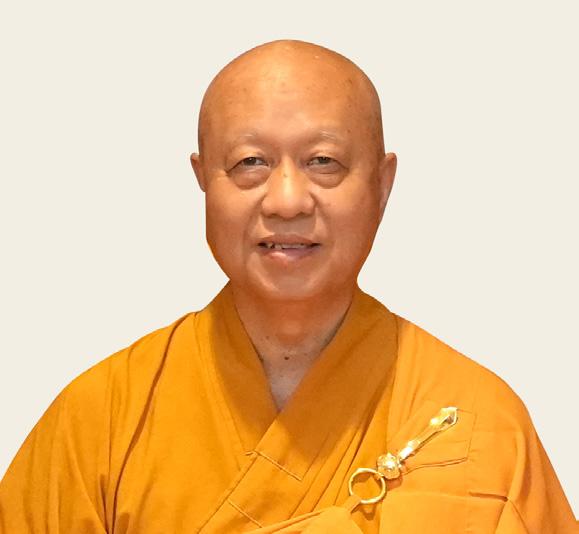
Ven. Chao Khun Fa Zhao BBM
昭坤法照 President

Mr Chua Meng Kiat
蔡明杰先生 Honorary Treasurer
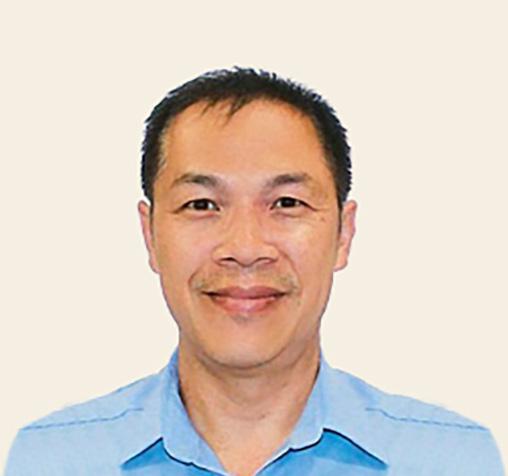
Mr Lee Kwok Weng
李国荣先生 Management Committee Member

Ven. Shi Zheng Ji
释正季 Vice President

Mr Khua Kian Kheng, Ivan PBM
柯建庆先生
Asst Honorary Secretary

Ms Ng Leng Ying, Micky
吴玲莹女士 Management Committee Member

Mr Tay Khay Heng, Jimmy 郑嘉兴先生 Honorary Secretary

Mr Lim Swee Kiang, Vincent 林瑞强先生
Asst Honorary Treasurer

Mr Tan Ming Tatt , Christopher 陈明达先生 Management Committee Member

Mr Thong Min Hua
唐明华先生
Management Committee Member
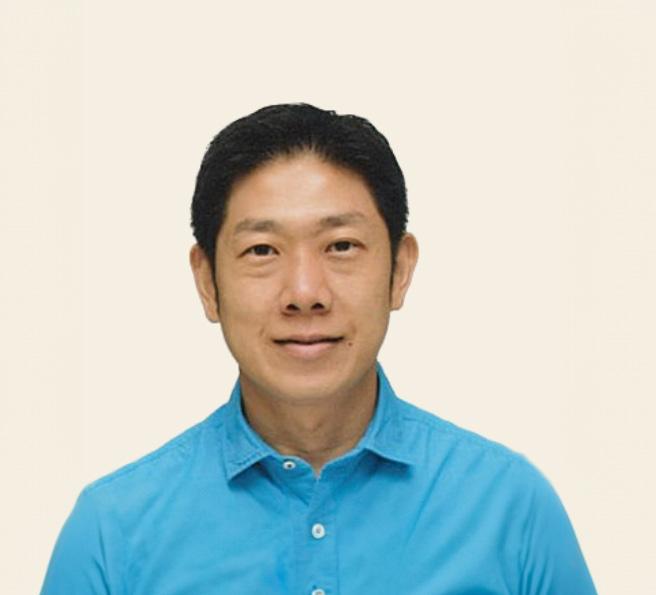
Mr Saw Tee Kiam, James 苏智谦先生
Management Committee Member

Mr Toh Kian Foo, Ryan 杜健富先生 Management Committee Member
During the financial year ended 31 December 2024, there were 4 Management Committee (MC) meetings held. The attendance rates as shown below: 截至2024年12月31日的财政年度中,举行了4次理事会议。 出席率如下图:
Venerable Chao Khun Fa Zhao BBM 昭 坤 法 照 President
Venerable Shi Zheng Ji 释 正 季 Vice President
Mr Tay Khay Heng, Jimmy 郑 嘉 兴 先 生 Honorary Secretary
Mr Khua Kian Kheng, Ivan 柯 建 慶 先 生 Assistant Honorary Secretary
Mr Chua Meng Kiat 蔡 明 杰 先 生 Honorary Treasurer
Mr Lim Swee Kiang, Vincent 林 瑞 強 先 生 Assistant Honorary Treasurer 75%
Ms Ng Leng Ying, Micky 吴 玲 瑩 女 士 Management Committee Member 75%
Mr Tan Min Tatt, Christopher 陈 明 达 先 生 Management Committee Member 100%
Mr Thong Min Hua 唐 明 华 先 生 Management Committee Member 75%
Mr Saw Tee Kiam, James 蘇 智 謙 先 生 Management Committee Member 75%
Mr Lee Kwok Weng 李 國 榮 先 生 Management Committee Member 75%
Mr Toh Kian Foo, Ryan 杜 健 富 先 生 Management Committee Member 100%
主席
昭坤法照 BBM President
Venerable Chao Khun Fa Zhao BBM
理事会 Management Committee
执行董事 Executive Director
副执行董事 Deputy Executive Director
寺务部门 Donor Relations Dept
资讯科技组 Information Technology Section

财务与行政部门 Finance & Admin Dept 僧伽 Sangha
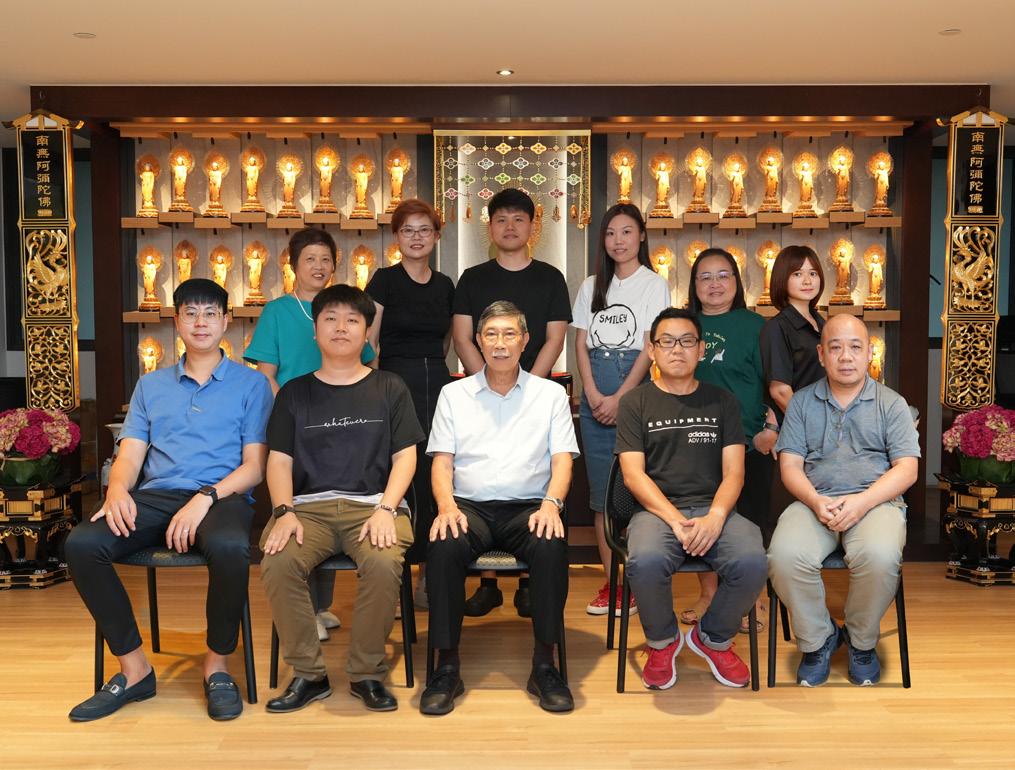

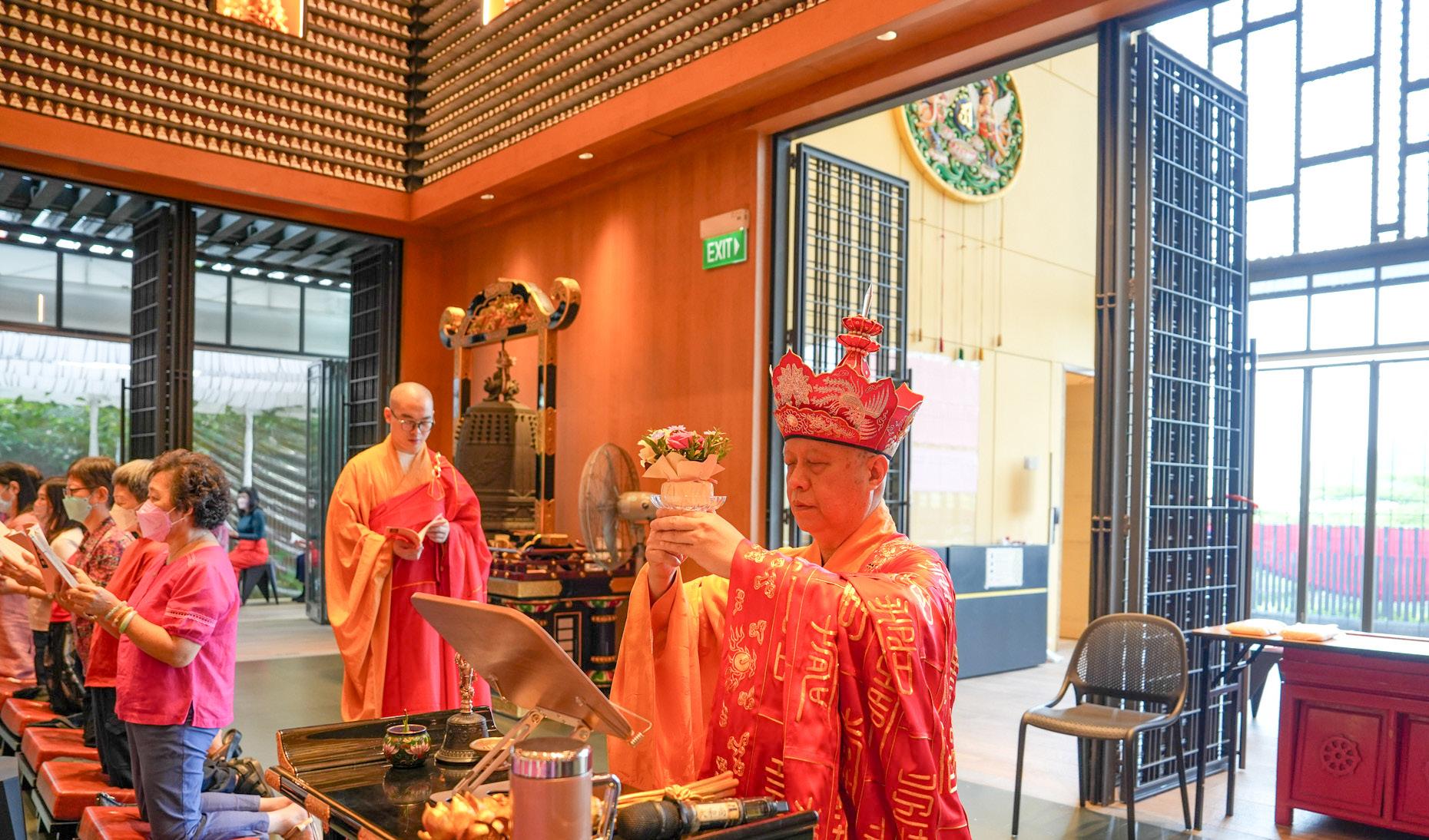

般若法会 Astasahasrika Prajnaparamita Sutra Ceremony
January 2024
岁末斋天 Golden Light Repentance
January 2024
迎接新年 Medicine Buddha Puja
February 2024



弥勒佛诞法会 Maitreya Buddha's Birthday Ceremony
February 2024
第三十七届 万佛法会
10,000 Buddhas Ceremony
February 2024
新春斋天法会 Offering Ceremony for Buddhas’and Celestial Guardians
March 2024



千手观音诞法会 Avalokiteshvara Bodhisattva’s Birthday Ceremony
March 2024
八关斋法会 Eight Precepts Ceremony
March, June, November 2024
华严法会 Avatamsaka Repentance Ceremony
April 2024
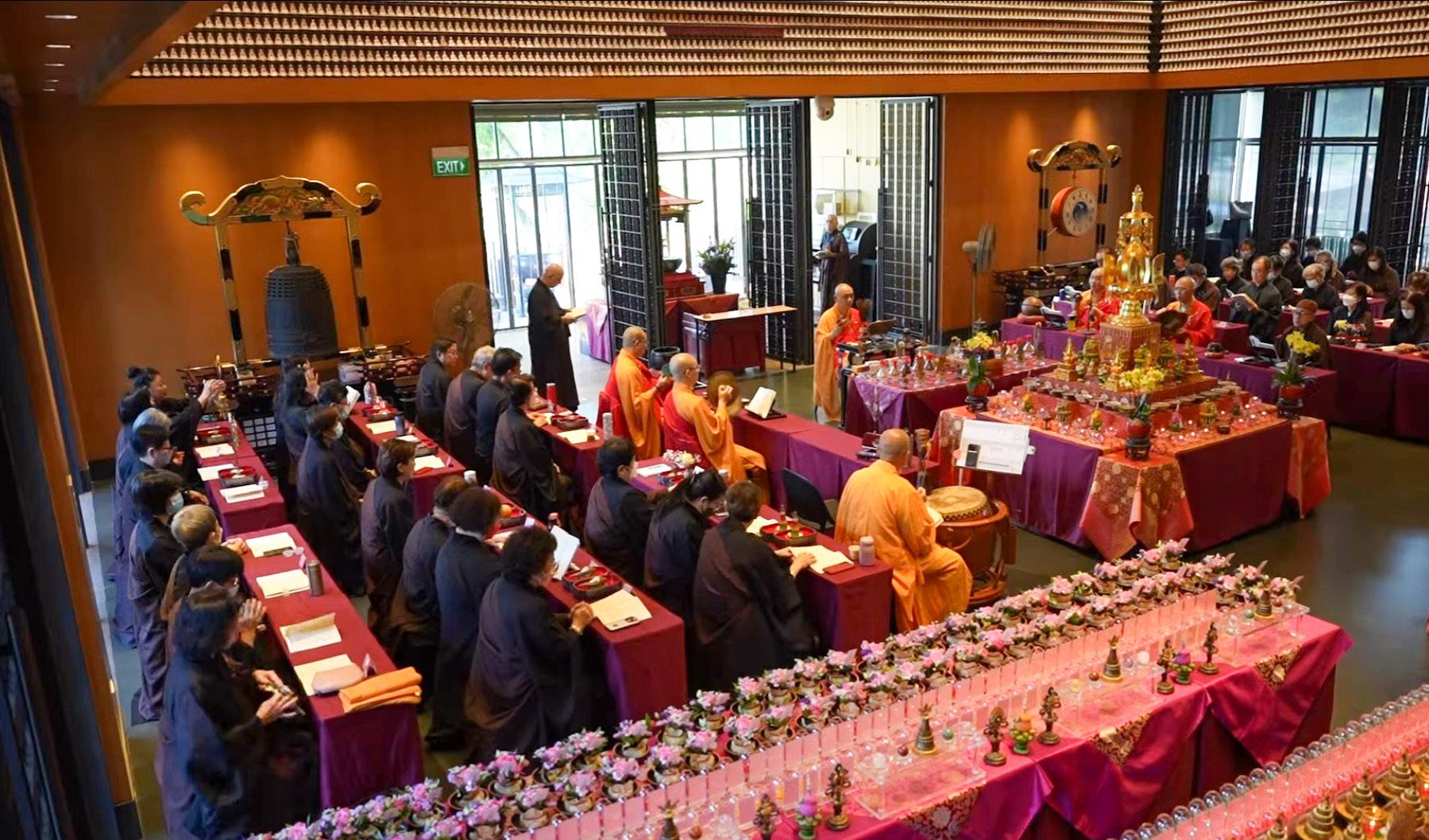


卫塞节 - 三重庆 Vesak Day Ceremony
May 2024
三皈五戒 Three Refuges Five Precepts
May 2024
法华经会 Recitation of Saddharma Pundarika Sutra
June 2024
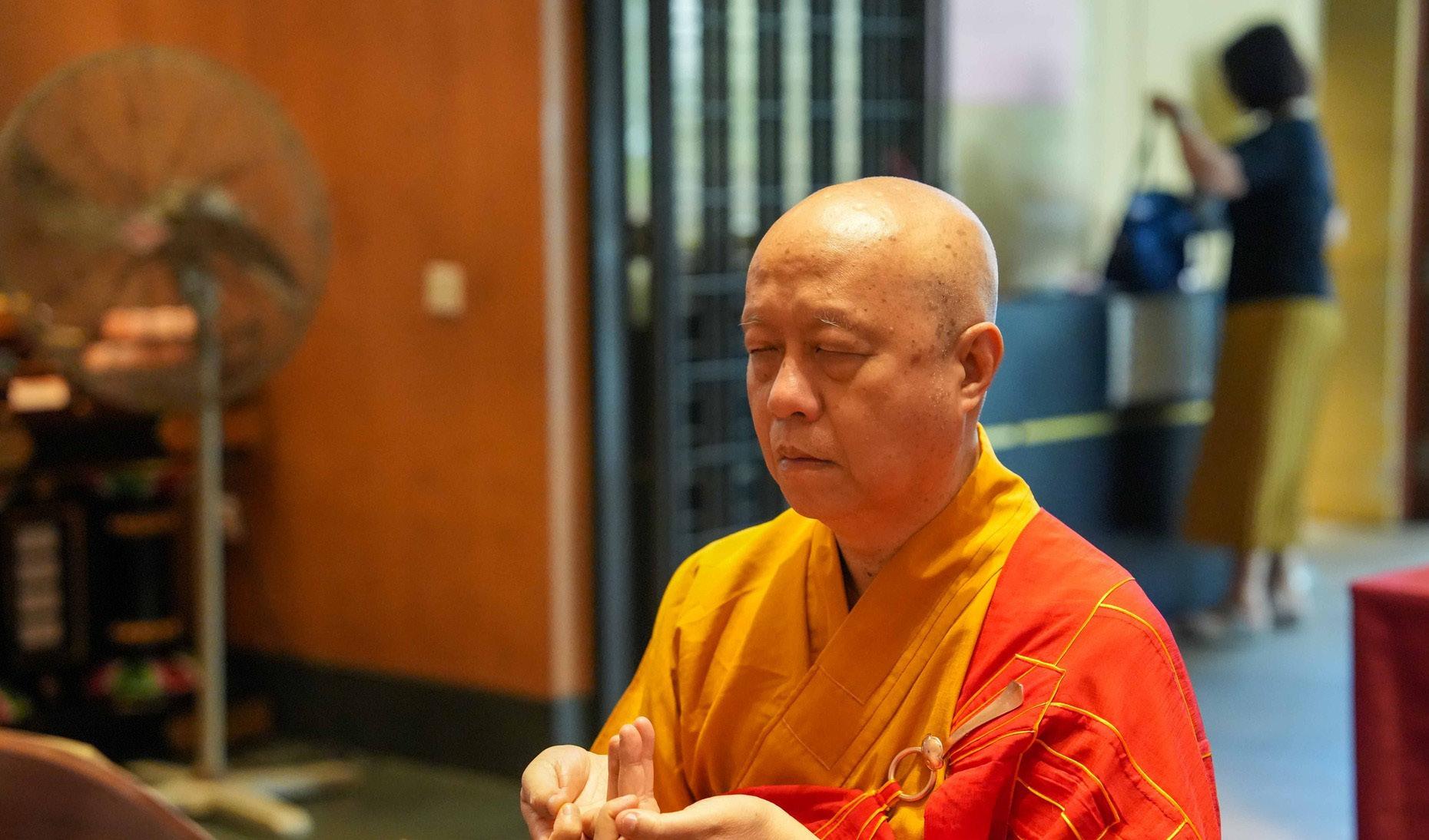


千手观音成道
纪念日法会
Avalokiteshvara Bodhisattva Enlightenment Ceremony
July 2024
盂兰胜会 Ullambana Ceremony
August 2024
国庆日祈福会
Singapore 59th National Day-Sutra Recitation
August 2024

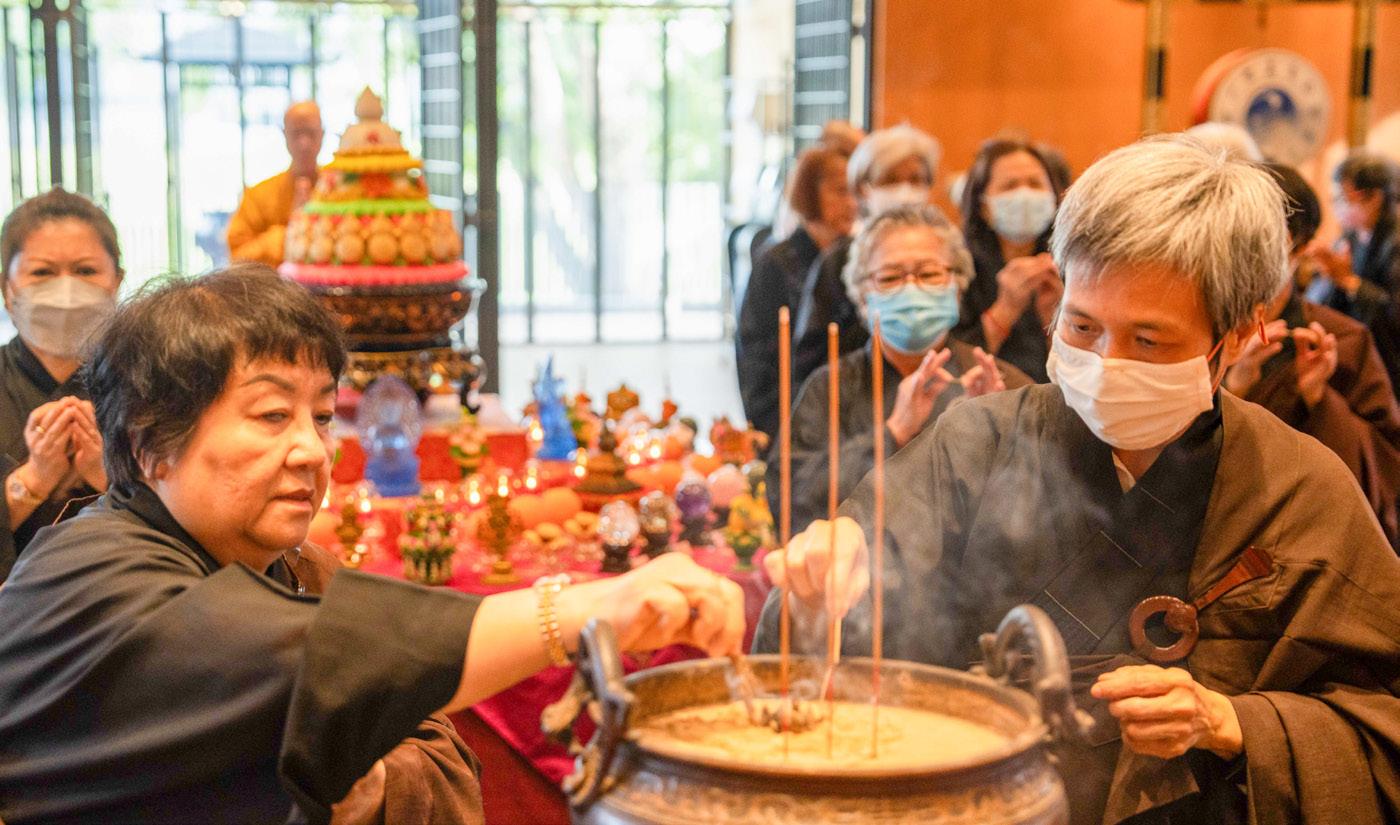

地藏菩萨诞法会 Ksitigarbha Bodhisattva’s Birthday Ceremony
August 2024
月光菩萨圣诞 Candraprabha Bodhisattva’s Birthday Ceremony
September 2024
千手观音出家 纪念日法会 Avalokiteshvara Bodhisattva Renunciation Ceremony
October 2024
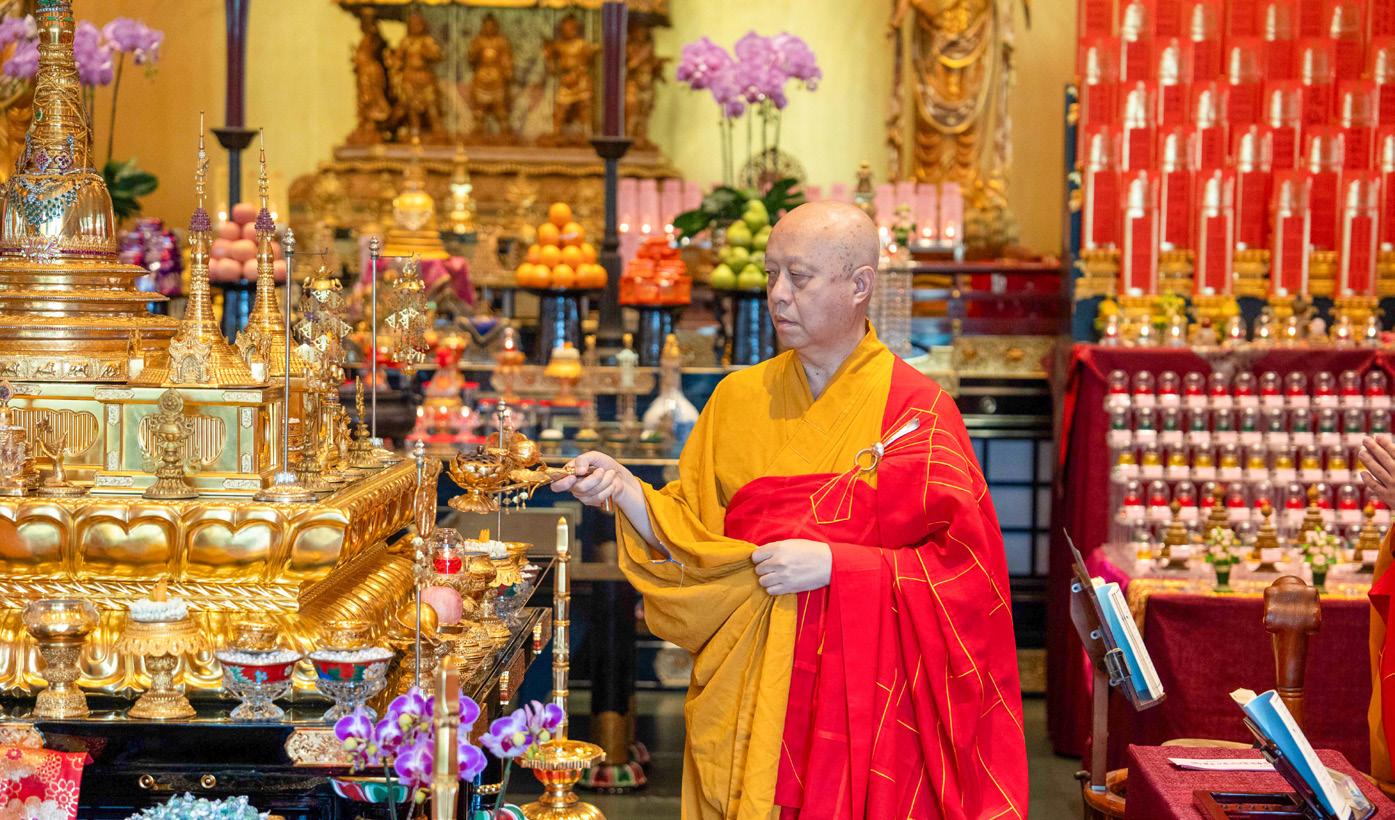


药师琉璃光七佛胜会 The Seven Medicine Buddhas Ceremony
October 2024
尊胜佛母荟供 Ushnishavijaya Offering Group Practice
November 2024
弥陀佛诞法会 Amitabha Buddha’s Birthday Ceremony
December 2024


护国金塔寺
慈善署注册号码: 1086
单一机构识别码: S92SS0036K
注册地址: 83 淡滨尼连路.
新加坡邮区 528740
信托人: 昭坤法照 BBM
余添辉居士
陈延基居士
药师法会 Medicine Buddha Ceremony
Every Lunar 7th 2024
慈悲梁皇宝忏共修 Emperor Liang Repentance Group Practice
Every Saturday 2024
银行: 华侨银行 渣打银行 大华银行 丰隆金融 中国银行 新加坡金融有限公司
法国巴黎银行
审计师: Credo Assurance LLP
1 Wat Ananda Metyarama Thai Buddhist Temple 2 Mahakaruna Buddhist Society
3 Singapore Chinese Dance Theatre
4 Foo Hai Ch'an Monastery
5 Tai Pei Yuen Temple
6 The Singapore Buddhist Lodge
7 The Singapore Chinese Buddhist Association
8 Golden Microphone Language Centre Pte Ltd
9 Cheng Hong Welfare Service Society
10 Pu Ji Si BRC 11 NanFang Arts Association
12 Disabled People's Association
13 Dover Park Hospice
Golden Pagoda Buddhist Temple
Charity Registration Number: 1086
UEN Number: S92SS0036K
Registered Address: 83 Tampines Link Singapore 528740
Trustees:
Venerable Chao Khun
Fa Zhao BBM
Mr. Ee Tiang Hwee
Mr. Tan Yen Kee
Bankers: Oversea-Chinese
Banking Corporation
Standard Chartered Bank
United Overseas Bank
Hong Leong Finance
Bank of China
Singapura Finance Limited
BNP Paribas
Auditor: Credo Assurance LLP
1. Introduction
We are committed to high standards of corporate governance, upholding the values of accountability and transparency within our organization. We comply with the requirements of the Code of Governance (for Charities and Institutions of a Public Character) issued by the Charity Council.
We are governed by a Management Committee (“MC”) whose 12 members are elected according to our Constitution. Presently, the MC comprises the President, the Vice President, the Honorary Secretary, Assistant Honorary Secretary, Honorary Treasurer, Assistant Honorary Treasurer and 6 other elected Board members. They bring with them skills and abilities in diverse areas such as accounting, audit, business, communications, engineering, finance, fundraising, human resource, management and technology. The MC ensures that we are run well and responsibly.
There is a maximum term limit of 4 consecutive years for the positions of Honorary Treasurer and Assistant Honorary Treasurer.
The MC conducts self-evaluation annually to assess its performance and effectiveness.
The MC meets at least 4 times a year. For the financial year from 1 Jan 2024 to 31 Dec 2024, there were 4 meetings.
MC meeting attendance record:
Venerable Chao Khun Fa Zhao BBM 24/06/2023 4/4
President Venerable Shi Zheng Ji 24/06/2023 3/4 Honorary Secretary
Mr Tay Khay Heng, Jimmy 24/06/2023 4/4
Asst Honorary Secretary Mr Khua Kian Kheng, Ivan 24/06/2023 1/4
Honorary Treasurer
Asst Honorary Treasurer
Mr Chua Meng Kiat 24/06/2023 4/4
Mr Lim Swee Kiang, Vincent 24/06/2023 3/4 Committee Member
Mr Tan Ming Tatt, Christopher 24/06/2023 4/4
Mr Saw Tee Kiam, James 24/06/2023 3/4
Mr Thong Min Hua 24/06/2023 3/4
Mr Lee Kwok Weng
24/06/2023 3/4
Mr Toh Kian Foo, Ryan 24/06/2023 4/4
Ms Ng Leng Ying, Micky 24/06/2023 3/4
Office Bearer’s Appointment & Occupation
Name
Venerable Chao Khun Fa Zhao BBM
Venerable Shi Zheng Ji
Current Board Appointment & Date
President 24/06/2023
Vice President 24/06/2023
Mr Tay Khay Heng, Jimmy Honorary Secretary 24/06/2023
Mr Khua Kian Kheng, Ivan
Mr Chua Meng Kiat
Mr Lim Swee Kiang, Vincent
Assistant Honorary Secretary 24/06/2023
Honorary Treasurer 24/06/2023
Assistant Honorary Treasurer 24/06/2023
First Board Appointment & Date (#) Occupation
President 21/02/1992
Vice President 24/06/2023
Abbot & President, Buddhist Temple
Resident Monk
Honorary Secretary 28/06/2019 Principal Project Manager
Assistant Honorary Secretary 28/06/2019 Executive Director
Honorary Treasurer 24/06/2023 Director
Assistant Honorary Treasurer 24/06/2023 Assistant Manager
# This refers to date of first appointment to the Board on a continuous basis.
Office Bearer’s Appointment in Affiliated Organization
Officer Bearers Affiliated Organisation
Buddha Tooth Relic Temple (Singapore)
Venerable Chao Khun Fa Zhao BBM
Mr Tay Khay Heng, Jimmy
Metta Welfare Association
Position in Affiliated Organisation
Abbot and President
1. President
2. Advisor of Nominating Committee
Metta School & Maitri School Chairman
1. Management Committee Member
Buddha Tooth Relic Temple (Singapore)
2. Chairman of Tenders & Contracts Committee
3. Member of Finance Committee
4. Management Committee Member
Metta Welfare Association
5. Chairman of Tenders & Contracts Committee
Metta Welfare Association
Mr Chua Meng Kiat
3. Sub-Committees
Buddha Tooth Relic Temple (Singapore)
1. Assistant Honorary Treasurer
2. Vice Chairman of Finance Committee
3. Vice Chairman of Community Partnership Committee
1. Information Technology Committee
To enhance our corporate governance, the MC has established the following 2 sub-committees with documented Terms of Reference: 1. Audit Committee 2. Finance Committee 4. Senior Management Team Name
Mr Ee Tiang Hwee Deputy Executive Director 01/07/2017
Our senior management team are professionals with the right skill sets and competencies to manage the organization and deliver the results expected by the MC.
5. Strategic Planning
The MC approves and reviews our Vision, Mission and Values to ensure we stay relevant in relation to the changing environment and needs. These are communicated to all stakeholders and the public through various platforms, including the annual report and co rporate website. The MC regularly reviews and updates our strategic plans to ensure that our activities are in line with our objectives.
The Finance Committee and the MC review and approve the annual budget prepared by management. The operating and capital expenditure budget is regularly monitored.
We are committed to disclosing audited statements that give an accurate and fair review of our financial position to ensure that they are in accordance with the requirements as specified by the authorities.
We have in place written procedures for financial matters in key areas which include procurement and controls, receipting, payment procedures, controls and system for the delegation of authority and limits of approval.
We adopt a rigorous enterprise risk management framework, and internal ISO audits are conducted yearly on key aspects of our operations. The Audit Committee assists the Management Committee (MC) in providing risk management oversight, while the Senior Managem ent Team monitors and ensures the integrity of the internal control systems.
Audits are conducted by external auditors periodically to ensure that our internal controls are in place and that our financial, investment, and fund - raising policies are adhered to. The findings and recommendations made by the internal and external auditors are reviewed by the Audit Committee and reported to the MC.
8. Donations
All donations collected are properly accounted for and promptly deposited.
9. Conflict of Interest Policy
We have in place policies and procedures to manage and avoid situations of conflict of interest. All MC members, Sub-Committees members and our staff are required to make declarations of conflict of interest at the start of their terms or at the point of hire, annually, and as soon as such conflict or the possibility of such conflict arises. When a conflict of interest situation arises, conflicted individuals are not allowed to participate in the decision-making process or vote on the matters where they have a conflict of interest.
10. Reserves Policy
We maintain some level of reserves to ensure long-term financial sustainability We maintain maximum reserves level of up to 5 years of annual operating expenditure. Our reserves exclude Investment Fund, Medicine Buddha Charity Fund and Sinking Fund.
11. Personal Data Protection Policy
We have set in place a privacy policy available on our corporate website. We have various processes to comply with the Personal Data Protection Act 2012 (“PDPA”). Data is used only for purposes disclosed unless otherwise permitted under the law. Reasonable security arrangements are also in place to comply with PDPA obligations.
12. Disclosure and Transparency
We publish our Annual Report on our corporate website and it includes comprehensive information on our programmes, activities, audited financial statements, MC members and sub-committees, and senior management team.
No MC members receive any remuneration for their services.
No staff member is involved in setting his or her own remuneration.
No staff member is a close member of the family of the executive head or board members
Governance Evaluation Checklist (Tier 1)
Please note that this checklist is based on the Code of Governance 2023 and is meant for self-assessment only. Submission of GEC is done via the Charity Portal.
Intructions: Please select your reponse for each item. Input the explanation if the secltion is "No" or "Partial Compliance".
SN Call for Action
1 Clearly state the charitable purposes (For example, vision and mission, objectives, use of resources, activities, and so on) and include the objectives in the charity’s governing instrument. Publish the stated charitable purposes on platforms (For example, Charity Portal, website, social media channels, and so on) that can be easily accessed by the public.
2 Develop and implement strategic plans to achieve the stated charitable purposes.
3 Have the Board review the charity’s strategic plans regularly to ensure that the charity is achieving its charitable purposes, and monitor, evaluate and report the outcome and impact of its activities.
4 The Board and Management are collectively responsible for achieving the charity’s charitable purposes. The roles and responsibilities of the Board and Management should be clear and distinct.
5 The Board and Management should be inducted and undergo training, where necessary, and their performance reviewed regularly to ensure their effectiveness.
6 Document the terms of reference for the Board and each of its committees. The Board should have committees (or desig nated Board member(s)) to oversee the following areas*, where relevant to the charity:
a. Audit
b. Finance
* Other areas include Programmes and Services, Fund-raising, Appointment/ Nomination, Human Resource, and Investment.
7 Ensure the Board is diverse and of an appropriate size, and has a good mix of skills, knowledge, and experience. All Board members should exercise independent judgement and act in the best interest of the charity.
8 Develop proper processes for leadership renewal. This includes establishing a term limit for each Board member. All Board members must submit themselves for re-nomination and reappointment, at least once every three years.
9 Develop proper processes for leadership renewal. This includes establishing a term limit for the Treasurer (or equivalent position).
For Treasurer (or equivalent position) only:
a. The maximum term limit for the Treasurer (or equivalent position like a Finance Committee Chairman, or key person on the Board responsible for overseeing the finances of the charity) should be four consecutive years. If there is no Board member who oversee the finances, the Chairman will take on the role.
i. After meeting the maximum term limit for the Treasurer, a Board member’s reappointment to the position of Treasurer (or an equivalent position may be considered after at least a two-year break.
ii. Should the Treasurer leave the position for less than two years, and when he/she is being re-appointed, the Treasurer’s years of service would continue from the time he/she stepped down as Treasurer.
10 Ensure the Board has suitable qualifications and experience, understands its duties clearly, and performs well.
a. No staff should chair the Board and staff should not comprise more than one-third of the Board.
11 Ensure the Management has suitable qualifications and experience, understands its duties clearly, and performs well.
a. Staff must provide the Board with complete and timely information and should not vote or participate in the Board’s decision-making.
12 Conduct appropriate background checks on the members of the Board and Management to ensure they are suited to work at the charity.
13 Document the processes for the Board and Management to declare actual or potential conflicts of interest, and the measures to deal with these conflicts of interest when they arise.
a. A Board member with a conflict of interest in the matter(s) discussed should recuse himself/herself from the meeting and should not vote or take part in the decision-making during the meeting.
14 Ensure that no Board member is involved in setting his/her own remuneration directly or indirectly. 3.3
15 Ensure that no staff is involved in setting his/her own remuneration directly or indirectly.
16 Establish a Code of Conduct that reflects the charity’s
Conduct is applied appropriately.
17 Take into consideration the ESG factors when conducting the charity’s activities.
18 Implement and regularly review key policies and procedures to ensure that they continue to support the charity’s objectives.
a. Ensure the Board approves the annual budget for the charity’s plans and regularly reviews and monitors its income and expenditures (For example, financial assistance, matching grants, donations by board members to the charity, funding, staff costs and so on).
19 Implement and regularly review key policies and procedures to ensure that they continue to support the charity’s objectives.
b. Implement appropriate internal controls to manage and monitor the charity’s funds and resources. This includes key processes such as:
i. Revenue and receipting policies and procedures; ii. Procurement and payment policies and procedures; and iii. System for the delegation of authority and limits of approval.
20 Seek the Board’s approval for any loans, donations, grants, or financial assistance provided by the charity which are not part of the core charitable programmes listed in its policy. (For example, loans to employees/subsidiaries, grants or financial assistance to business entities).
21 Regularly identify and review the key risks that the charity is exposed to and refer to the charity’s processes to manage these risks.
22 Disclose or submit the necessary documents (such as Annual Report, Financial Statements, GEC, and so on) in accordance with the requirements of the Charities Act, its Regulations, and other frameworks (For example, Charity Transparency Framework and so on).
23 Generally, Board members should not receive remuneration for their services to the Board. Where the charity’s governing instrument expressly permits remuneration or benefits to the Board members for their services, the charity should provide reasons for allowing remuneration or benefits and disclose in its annual report the exact remuneration and benefits received by each Board member.
24 The charity should disclose the following in its annual report:
a. Number of Board meetings in the year; and b. Each Board member’s attendance.
25 The charity should disclose in its annual report the total annual remuneration (including any remuneration received in the charity’s subsidiaries) for each of its three highest-paid staff, who each receives remuneration exceeding $100,000, in incremental bands of $100,000. Should any of the three highest-paid staff serve on the Board of the charity, this should also be disclosed. If none of its staff receives more than $100,000 in annual remuneration each, the charity should disclose this fact.
26 The charity should disclose in its annual report the number of paid staff who are close members of the family of the Executive Head or Board members, and whose remuneration exceeds $50,000 during the year. The annual remuneration of such staff should be listed in incremental bands of $100,000. If none of its staff is a close member of the family of the Executive Head or Board members and receives more than $50,000 in annual remuneration, the charity should disclose this fact.
27 Implement clear reporting structures so that the Board, Management, and staff can access all relevant information, advice, and resources to conduct their roles effectively.
a. Record relevant discussions, dissenting views and decisions in the minutes of general and Board meetings. Circulate the minutes of these meetings to the Board as soon as practicable.
28 Implement clear reporting structures so that the Board, Management, and staff can access all relevant information, advice, and resources to conduct their roles effectively.
a. The Board meetings should have an appropriate quorum of at least half of the Board, if a quorum is not stated in the charity’s governing instrument.
29 Develop and implement strategies for regular communication with the charity’s stakeholders and the public (For example, focus on the charity’s branding and overall message, raise awareness of its cause to maintain or increase public support, show appreciation to supporters, and so on).
30 Listen to the views of the charity’s stakeholders and the public and respond constructively. 6.2
$4,436,508
(Registration No. S92SS0036K)
(Incorporated in the Republic of Singapore )
For the financial year ended 31 December 2024
CREDO ASSURANCE LLP
Public Accountants and Chartered Accountants of Singapore
Registration no. T15LL0120C
545 Orchard Road #10-06
Far East Shopping Centre, Singapore 238882
Tel: (65) 9837 2633

Accountants and Chartered Accountants of Singapore
Opinion
We have audited the financial statements of Golden Pagoda Buddhist Temple (‘the Temple), which comprise the statement of financial position of the Temple as at 31 December 2024, and the statement of financial activities, statement of changes in funds and statement of cash flows for the year then ended, and notes to the financial statements, including material accounting policy information
In our opinion, the accompanying financial statements are properly drawn up in accordance with the provisions of the Societies Act 1996 (the Societies Act), the Charities Act 1994 and other relevant regulations (the Charities Act and Regulations) and Charities Accounting Standard (CAS) so as to present fairly, in all material respects, the financial position of the Temple as at 31 December 2024 and the financial performance, changes in funds and cash flows of the Temple for the year ended on that date.
We conducted our audit in accordance with Singapore Standards on Auditing (SSAs). Our responsibilities under those standards are further described in the Auditor’s Responsibilities for the Audit of the Financial Statements section of our report. We are independent of the Temple in accordance with the Accounting and Corporate Regulatory Authority (ACRA) Code of Professional Conduct and Ethics for Public Accountants and Accounting Entities (ACRA Code) together with the ethical requirements that are relevant to our audit of the financial statements in Singapore, and we have fulfilled our other ethical responsibilities in accordance with these requirements and the ACRA Code. We believe that the audit evidence we have obtained is sufficient and appropriate to provide a basis for our opinion.
Management Committee is responsible for the other information. The other information comprises the Statement by Management Committee set out on page 1 and the information included in the Annual Report, but does not include the financial statements and our auditor’s report thereon.
Our opinion on the financial statements does not cover the other information and we do not express any form of assurance conclusion thereon.
In connection with our audit of the financial statements, our responsibility is to read the other information and, in doing so, consider whether the other information is materially inconsistent with the financial statements or our knowledge obtained in the audit, or otherwise appears to be materially misstated. If, based on the work we have performed, we conclude that there is a material misstatement of this other information, we are required to report that fact. We have nothing to report in this regard.

Responsibilities of Management and Committee for the Financial Statements
Management Committee is responsible for the preparation and fair presentation of the financial statements in accordance with the provisions of the Societies Act, the Charities Act, CAS and for such internal control as management determines is necessary to enable the preparation of financial statements that are free from material misstatement, whether due to fraud or error.
In preparing the financial statements, Management Committee is responsible for assessing the Temple’s ability to continue as a going concern, disclosing, as applicable, matters related to going concern and using the going concern basis of accounting unless management either intends to liquidate the Temple or to cease operations, or has no realistic alternative but to do so.
Those charged with governance are responsible for overseeing the Temple’s financial reporting process.
Our objectives are to obtain reasonable assurance about whether the financial statements as a whole are free from material misstatement, whether due to fraud or error, and to issue an auditor’s report that includes our opinion. Reasonable assurance is a high level of assurance, but is not a guarantee that an audit conducted in accordance with SSAs will always detect a material misstatement when it exists. Misstatements can arise from fraud or error and are considered material if, individually or in the aggregate, they could reasonably be expected to influence the economic decisions of users taken on the basis of these financial statements.
As part of an audit in accordance with SSAs, we exercise professional judgement and maintain professional scepticism throughout the audit. We also:
• Identify and assess the risks of material misstatement of the financial statements, whether due to fraud or error, design and perform audit procedures responsive to those risks, and obtain audit evidence that is sufficient and appropriate to provide a basis for our opinion. The risk of not detecting a material misstatement resulting from fraud is higher than for one resulting from error, as fraud may involve collusion, forgery, intentional omissions, misrepresentations, or the override of internal control.
• Obtain an understanding of internal control relevant to the audit in order to design audit procedures that are appropriate in the circumstances, but not for the purpose of expressing an opinion on the effectiveness of the Temple’s internal control.
• Evaluate the appropriateness of accounting policies used and the reasonableness of accounting estimates and related disclosures made by management.

545 Orchard Road
#10-06 Far East Shopping Centre Singapore 238882
T: (65) 9837 2633
Public Accountants and Chartered Accountants of Singapore Credo Assurance LLP
Auditor’s Responsibilities for the Audit of the Financial Statements (Continued)
• Conclude on the appropriateness of Management Committee’s use of the going concern basis of accounting and, based on the audit evidence obtained, whether a material uncertainty exists related to events or conditions that may cast significant doubt on the Temple’s ability to continue as a going concern. If we conclude that a material uncertainty exists, we are required to draw attention in our auditor’s report to the related disclosures in the financial statements or, if such disclosures are inadequate, to modify our opinion. Our conclusions are based on the audit evidence obtained up to the date of our auditor’s report. However, future events or conditions may cause the Temple to cease to continue as a going concern.
• Evaluate the overall presentation, structure and content of the financial statements, including the disclosures, and whether the financial statements represent the underlying transactions and events in a manner that achieves fair presentation.
We communicate with those charged with governance regarding, among other matters, the planned scope and timing of the audit and significant audit findings, including any significant deficiencies in internal control that we identify during our audit.
In our opinion, the accounting and other records required to be kept by the Temple have been properly kept in accordance with the provision of Societies Regulations enacted under Societies Act, Charities Act and Regulations.

CREDO ASSURANCE LLP
Public Accountants and Chartered Accountants
Singapore, 13 June 2025
STATEMENT OF FINANCIAL POSITION AS AT 31 DECEMBER 2024
FUNDS
STATEMENT OF CHANGES IN FUND FOR THE FINANCIAL YEAR ENDED 31 DECEMBER 202 4
Balance at 1 January 202 3
(657,054) (440,826)
2,622,998
(182,661)
Balance at 31 December 202 3
1,737,437 15,002,744 30,677,985 Total comprehensive income for the financial year
Balance at 31 December 202 4 11,673,619 2,622,998 11 5 ,580 1,737,437 14,345,690 30,495,324
STATEMENT OF CASH FLOWS FOR THE FINANCIAL YEAR ENDED 31 DECEMBER 2024
The accompanying notes form an integral part of these financial statements.
These notes form an integral part of and should be read in conjunction with the accompanying financial statements.
Golden Pagoda Buddhist Temple (the “Temple”) was registered under the Societies Act 1966 on 12 February 1992 The Temple became a registered charity under the Charities Act 1994 on 20 March 1995. The address of its registered address and principal place of activities are located at 83 Tampines Link, Singapore 528740
The principal activities of the Temple are to act as a place of Buddhism worship, promote the Buddhist religion and to grant relief and aid to the sick, poor and needy
The financial statements of the Temple for the financial year ended 31 December 2024 were authorised for issue by the Management Committee on the date of Statement by the Management Committee.
2 Material accounting policy information
2.1 Basis of preparation
The financial statements have been prepared in accordance with the Societies Act 1966, the Charities Act 1994 and Charities Accounting Standards (“CAS”).
The financial statements which are presented in Singapore dollar (“$”) except when otherwise stated), have been prepared on the historical cost basis, except as disclosed in the accounting policies below.
The preparation of these financial statements in conformity with CAS requires the use of estimates and assumptions that affect the reported amounts of assets and liabilities and disclosure of contingent assets and liabilities at the date of the financial statements and the reported amounts of revenues and expenses during the financial year. Although these estimates are based on Management Committee’s best knowledge of current events and actions and historical experiences and various other factors that are believed to be reasonable under the circumstances, actual results may ultimately differ from those estimates.
The estimates and underlying assumptions are reviewed on an ongoing basis. Revisions to accounting estimates are recognised in the period in which the estimate is revised if the revision affects only that period, or in the period of revision and future periods, if the revision affects both current and future periods. The areas involving a higher degree of judgement or complexity or areas where assumptions are significant to the financial statements are disclosed in Note 3.
2.2
The accounting policies adopted are consistent with those of the previous financial year except that in the current financial year, the Temple has adopted all the new and amended standards which are relevant to the Temple and are effective for annual financial period beginning on or after 1 January 2024 The adoption of these standards did not have any material effect on the financial performance or position of the Temple
2. Material accounting policy information (Continued)
Transactions in foreign currencies are measured in the respective functional currencies of the Temple and are recorded on initial recognition in the functional currencies at exchange rates approximating those ruling at the transaction dates. Monetary assets and liabilities denominated in foreign currencies are translated at the rate of exchange ruling at the end of the reporting period. Non-monetary items that are measured in terms of historical cost in a foreign currency are translated using the exchange rates as at the dates of the initial transactions. Nonmonetary items measured at fair value in a foreign currency are translated using the exchange rates at the date when the fair value was measured.
The Temple assesses at each reporting date whether there is an indication that an asset may be impaired. If any indication exists, (or, where applicable, when an annual impairment testing for an asset is required), the Temple makes an estimate of the asset’s recoverable amount.
An asset’s recoverable amount is the higher of an asset’s or cash-generating unit’s fair value less costs of disposal and its value in use and is determined for an individual asset, unless the asset does not generate cash inflows that are largely independent of those from other assets or group of assets.
Where the carrying amount of an asset or cash-generating unit exceeds its recoverable amount, the asset is considered impaired and is written down to its recoverable amount.
Impairment losses are recognised in profit or loss.
A previously recognised impairment loss is reversed only if there has been a change in the estimates used to determine the asset’s recoverable amount since the last impairment loss was recognised. If that is the case, the carrying amount of the asset is increased to its recoverable amount. That increase cannot exceed the carrying amount that would have been determined, net of depreciation, had no impairment loss been recognised previously. Such reversal is recognised in profit or loss.
Any revaluation surplus is recognised in other comprehensive income and accumulated in equity under the asset revaluation reserve, except to the extent that it reverses a revaluation decrease of the same asset previously recognised in profit or loss, in which case the increase is recognised in profit or loss. A revaluation deficit is recognised in profit or loss, except to the extent that it offsets an existing surplus on the same asset carried in the asset revaluation reserve.
Any accumulated depreciation as at the revaluation date is eliminated against the gross carrying amount of the asset and the net amount is restated to the revalued amount of the asset. The revaluation surplus included in the asset revaluation reserve in respect of an asset is transferred directly to retained earnings on retirement or disposal of the asset.
Freehold land has an unlimited useful life and therefore is not depreciated.
2. Material accounting policy information (Continued)
2.5 Property, plant and equipment (Continued)
Depreciation is computed on a straight-line method over the estimated useful lives of the assets as follows:
The carrying values of property, plant and equipment are reviewed for impairment when events or changes in circumstances indicate that the carrying value may not be recoverable.
The residual value, estimated useful lives and depreciation method are reviewed at each reporting period and adjusted prospectively, if appropriate.
An item of property, plant and equipment is derecognised upon disposal or when no future economic benefits are expected from its use or disposal. Any gain or loss arising from derecognition of the assets is included in profit or loss in the period that the assets are derecognised.
2.6 Financial instruments
(a) Financial assets
Initial recognition and measurement
Financial assets are recognised when, and only when the entity becomes party to the contractual provisions of the instruments.
At initial recognition, the Temple measures a financial asset at its fair value plus, in the case of a financial asset not at fair value through profit or loss (FVPL), transaction costs that are directly attributable to the acquisition of the financial asset. Transaction costs of financial assets carried at FVPL are expensed in profit or loss.
Trade receivables are measured at the amount of consideration to which the Temple expects to be entitled in exchange for transferring promised goods or services to a customer, excluding amounts collected on behalf of third party, if the trade receivables do not contain a significant financing component at initial recognition.
2. Material accounting policy information (Continued)
2.6 Financial instruments (Continued)
(a) Financial assets (Continued)
Subsequent measurement
Investment in debt instruments
Subsequent measurement of debt instruments depends on the Temple’s business model for managing the asset and the contractual cash flow characteristics of the asset. The three measurement categories for classification of debt instruments are amortised cost, fair value through other comprehensive income (FVOCI) and FVPL. The Temple only has debt instruments at amortised cost.
Financial assets that are held for the collection of contractual cash flows where those cash flows represent solely payments of principal and interest are measured at amortised cost. Financial assets are measured at amortised cost using the effective interest method, less impairment. Gains and losses are recognised in profit or loss when the assets are derecognised or impaired, and through the amortisation process.
Derecognition
A financial asset is derecognised where the contractual right to receive cash flows from the asset has expired. On derecognition of a financial asset in its entirety, the difference between the carrying amount and the sum of the consideration received and any cumulative gain or loss that had been recognised in other comprehensive income for debt instruments is recognised in profit or loss.
(b) Financial liabilities
Initial recognition and measurement
Financial liabilities are recognised when, and only when, the Temple becomes a party to the contractual provisions of the financial instrument. The Temple determines the classification of its financial liabilities at initial recognition.
All financial liabilities are recognised initially at fair value plus in the case of financial liabilities not at FVPL, directly attributable transaction costs.
Subsequent measurement
After initial recognition, financial liabilities that are not carried at FVPL are subsequently measured at amortised cost using the effective interest method. Gains and losses are recognised in profit or loss when the liabilities are derecognised, and through the amortisation process.
Derecognition
A financial liability is derecognised when the obligation under the liability is discharged or cancelled or expires. On derecognition, the difference between the carrying amounts and the consideration paid is recognised in profit or loss.
2. Material accounting policy information (Continued)
The Temple recognises an allowance for expected credit losses (ECLs) for all debt instruments not held at FVPL. ECLs are based on the difference between the contractual cash flows due in accordance with the contract and all the cash flows that the Temple expects to receive, discounted at an approximation of the original effective interest rate. The expected cash flows will include cash flows from the sale of collateral held or other credit enhancements that are integral to the contractual terms.
ECLs are recognised in two stages. For credit exposures for which there has not been a significant increase in credit risk since initial recognition, ECLs are provided for credit losses that result from default events that are possible within the next 12-months (a 12-month ECL). For those credit exposures for which there has been a significant increase in credit risk since initial recognition, a loss allowance is recognised for credit losses expected over the remaining life of the exposure, irrespective of timing of the default (a lifetime ECL).
For trade receivables, the Temple applies a simplified approach in calculating ECLs. Therefore, the Temple does not track changes in credit risk, but instead recognises a loss allowance based on lifetime ECLs at each reporting date. The Temple has established a provision matrix that is based on its historical credit loss experience, adjusted for forward-looking factors specific to the debtors and the economic environment which could affect debtors’ ability to pay.
The Temple considers a financial asset in default when contractual payments are 60 days past due. However, in certain cases, the Temple may also consider a financial asset to be in default when internal or external information indicates that the Temple is unlikely to receive the outstanding contractual amounts in full before taking into account any credit enhancements held by the Temple. A financial asset is written off when there is no reasonable expectation of recovering the contractual cash flows.
Cash and cash equivalents comprise cash at bank and on hand which are subject to an insignificant risk of changes in value.
2.9
General
Provisions are recognised when the Temple has a present obligation (legal or constructive) as a result of a past event, it is probable that an outflow of resources embodying economic benefits will be required to settle the obligation and the amount of the obligation can be estimated reliably.
Provisions are reviewed at the end of each reporting period and adjusted to reflect the current best estimate. If it is no longer probable that an outflow of economic resources will be required to settle the obligation, the provision is reversed. If the effect of the time value of money is material, provisions are discounted using a current pre-tax rate that reflects, where appropriate, the risks specific to the liability. When discounting is used, the increase in the provision due to the passage of time is recognised as a finance cost.
Provisions for assurance-type warranty-related costs are recognised when the product is sold or service provided. Initial recognition is based on historical experience. The initial estimate of warranty-related costs is revised annually.
2. Material accounting policy information (Continued)
2.10 Government grants
Government grants are recognised as a receivable when there is reasonable assurance that the grant will be received and all attached conditions will be complied with.
When the grant relates to an expense item, it is recognised as income on a systematic basis over the periods that the related costs, for which it is intended to compensate, are expensed. When the grant relates to an asset, the fair value is recognised as deferred income on the statement of financial position and is recognised as income in equal amounts over the expected useful life of the related asset.
When loans or similar assistance are provided by governments or related institutions with an interest rate below the current applicable market rate, the effect of this favourable interest is regarded as additional government grant.
2.11 Revenue
Revenue comprises the fair value of the consideration received or receivable for the services rendered in the ordinary course of the Temple’s activities. Revenue is recognised as follows:
Donations are recognised on receipt basis. Donations-in-kind are recognised when the fair value of the assets received can be reasonably ascertained.
Charitable incomes are generated from charity events and ceremonies.
Income from charitable activities is recognised on both receipt basis and accrued as and when they are committed.
Interest income is recognised on a time-proportion basis using the effective interest method.
The preparation of the Temple’s financial statements requires management to make judgements, estimates and assumptions that affect the reported amounts of revenues, expenses, assets and liabilities, and the disclosure of contingent liabilities at the end of each reporting period. Uncertainty about these assumptions and estimates could result in outcomes that require a material adjustment to the carrying amount of the asset or liability affected in the future periods.
3.1 Judgements made in applying accounting policies
The management is of the opinion that there are no significant judgments made in applying accounting estimates and policies that have a significant risk of causing a material adjustment to the carrying amounts of assets and liabilities within the next financial year
3.2
The key assumptions concerning the future and other key sources of estimation uncertainty at the end of the reporting period are discussed below. The Temple based its assumptions and estimates on parameters available when the financial statements were prepared. Existing circumstances and assumptions about future developments, however, may change due to market changes or circumstances arising beyond the control of the Temple. Such changes are reflected in the assumptions when they occur.
3. Significant accounting judgements and estimates (continued)
The cost of property, plant and equipment of the Temple is depreciated on a straight-line basis over the useful lives of property, plant and equipment. Management estimates the useful lives of these property, plant and equipment to be within 3 to 30 years. These are common life expectancies applied. The carrying amount of the Temple’s property, plant and equipment at the end of financial year was $15,881,298 (2023: $16,776,390). Changes in the expected level of usage and technological developments could impact on the economic useful lives and the residual values of these assets, therefore the future depreciation charges could be revised.
NOTESTO THE FINANCIAL STATEMENTS FOR THE FINANCIAL YEAR ENDED 31 DECEMBER 2024
5. Other receivables
Other receivables are short-term in nature, unsecured, interest-free and are denominated in Singapore Dollar.
6. Cash and bank deposits
Cash at banks earns interest at floating rates based on daily bank deposit rates. Short-term deposits are made for varying periods of between 3 to 12 months depending on the immediate cash requirements of the Temple, and earn interests at the respective short-term deposit rates. The effective interest rates ranged from 1.50% to 3.80% (2023 : 0.10% to 2.60%) per annum. The balances are denominated in Singapore Dollars.
Fixed deposit amounting to $50,000 (2023: $50,000) have been pledged to the bank for corporate credit card facility.
Cash and bank deposits are denominated in Singapore Dollar.
For the purpose of statement of cash flows, cash and cash equivalents comprise the following at the end of the financial year.
NOTESTO THE FINANCIAL STATEMENTS FOR THE FINANCIAL YEAR ENDED 31 DECEMBER 2024
7. Preservation of monuments
“Preservation of monuments” assets comprising artworks and artefacts are purchased by the Temple through an overseas auction. No depreciation is provided for these artworks/ artefacts since they have a similar nature to “antique” assets which have an infinite useful life.
8. Trade and other payables
Trade payables are non-interest bearing and are generally on 60 days’terms.
Deferred revenue primarily relates to donation received from donors for future worship events and ceremonies.
Other payables are denominated in Singapore Dollar
Other payables for related parties are unsecured, interest free and repayable on demand.
NOTESTO THE FINANCIAL STATEMENTS FOR THE FINANCIAL YEAR ENDED 31 DECEMBER 2024
9. Unrestricted and restricted funds
Designated Funds
“Designated funds” shall be accounted for as part of the charity’s unrestricted funds
Investment Fund
The investment fund was established in 1996. 20% of the net surplus of each financial year shall be set aside for the purpose of purchasing held-to-maturity investments.
Medicine Buddha Charity Fund
The Medicine Buddha charity fund was established in 2019 for charitable donation purposes and 20% of the net surplus of each financial year shall be set aside for the purpose. The fund will support the following social and charitable organisations.
a) Buddhist organisations;
b) Social service agencies;
c) Educational institutions;
d) Chinese and cultural organisations;
e) Overseas charities
f) Any other deserving organisations or individual, as decided by the Management Committee.
Sinking Fund
The sinking fund was established in 2008 to set aside funds for the repair, maintenance, renovations and upgrading works of the temple. 20% of the net surplus of each financial year shall be set aside for this purpose.
Restricted Funds
Reconstructed Temple Building account
This fund represents reconstruction cost of the temple building.
10. Charitable Income
11. Other Income
12.
13. Employee Benefits Expense
14. Governance and Administrative Expenses
15. Charitable donations and sponsorships
These donations and sponsorship relate to solicited cash donations made to local charities:
The disbursements of the above donations and sponsorships were approved by the Management Committee for amount above $10,000.
16. Significant related party transactions
The following transactions with related parties took place at terms agreed between the related parties during the financial year:
NOTESTO THE FINANCIAL STATEMENTS FOR THE FINANCIAL YEAR ENDED 31 DECEMBER 2024
17. Significant related party transactions (cont’d)
The Temple is governed by the Management Committee, which is the final authority and has overall responsibility for policy making and determination of all activities. The Temple has in place a conflict of interest policy in its code of conduct. All members of the Management Committee and senior management are required to declare their conflict of interest yearly.
A conflict of interest may arise when the Management Committee members or senior management have a personal direct or indirect interest in suppliers or service providers that submit quotations or tender. Accordingly, they are to evaluate whether he or she has direct or vested interest in the relevant suppliers or service providers. Full disclosure of interest shall be made and these interested persons are not to be involved in that approving of that procurement.
18. Financial instruments by category
At the reporting date, the aggregate carrying amounts of loans and receivables and financial liabilities at amortised cost were as follows:
19. Reserve position and policy
The Temple’s reserve position for financial year ended is as follows :
NOTESTO THE FINANCIAL STATEMENTS FOR THE FINANCIAL YEAR ENDED 31 DECEMBER 2024
19. Reserve position and policy (cont’d)
Reference :
D. Total Funds include unrestricted funds/ designated funds and restricted funds.
E. Total Annual Operating Expenditure include expenses related to cost of charitable activities and other operating expenses.
F. “Ratio of Fund to Annual Operating Expenditure” – the Fund refer to Accumulated Development and General Fund
The Temple’s Reserve Policy is as follows :
The maximum operating reserves for Golden Pagoda Buddhist Temple shall be give (5) years of the amount of the annual operating expenditure.
The operating reserves (unrestricted fund) shall include the following designated funds :
a. Sinking Fund
b. Investment Fund
c. Medicine Buddha Charity Fund
20. Fair values
The fair value of a financial instrument is the amount at which the instrument could be exchanged or settled between knowledgeable and willing parties in an arm’s length transaction.
The following methods and assumptions are used to estimate the fair value of each class of financial instruments for which it is practicable to estimate that value.
Cash and cash equivalents, other receivables and other payables
The carrying amounts of these balances approximate their fair values due to the short-term nature of these balances.
The carrying amounts of these payables approximate their fair values as they are subject to normal trade credit terms.
21. Funds management
The primary objective of the Temple’s funds management is to ensure that the funding from members and other sources are properly managed and used to support its operations.
The Temple manages its funds structure and makes adjustments to it, in light of changes in economic conditions. No changes were made in the objectives, policies or processes during the financial years ended 31 December 2024 and 2023 respectively.
The Temple is not subjected to externally imposed capital requirements.
22. Authorisation of financial statements for issue
The financial statements for the financial year ended 31 December 2024 were authorised for issue in accordance with the approval from Management Committee members on 2nd June 2025.

GOLDEN PAGODA BUDDHIST TEMPLE 83 Tampines Link Singapore 528740.
P : +65 65820988 E : services@gpbt.org.sg
www.goldenpagoda.org.sg